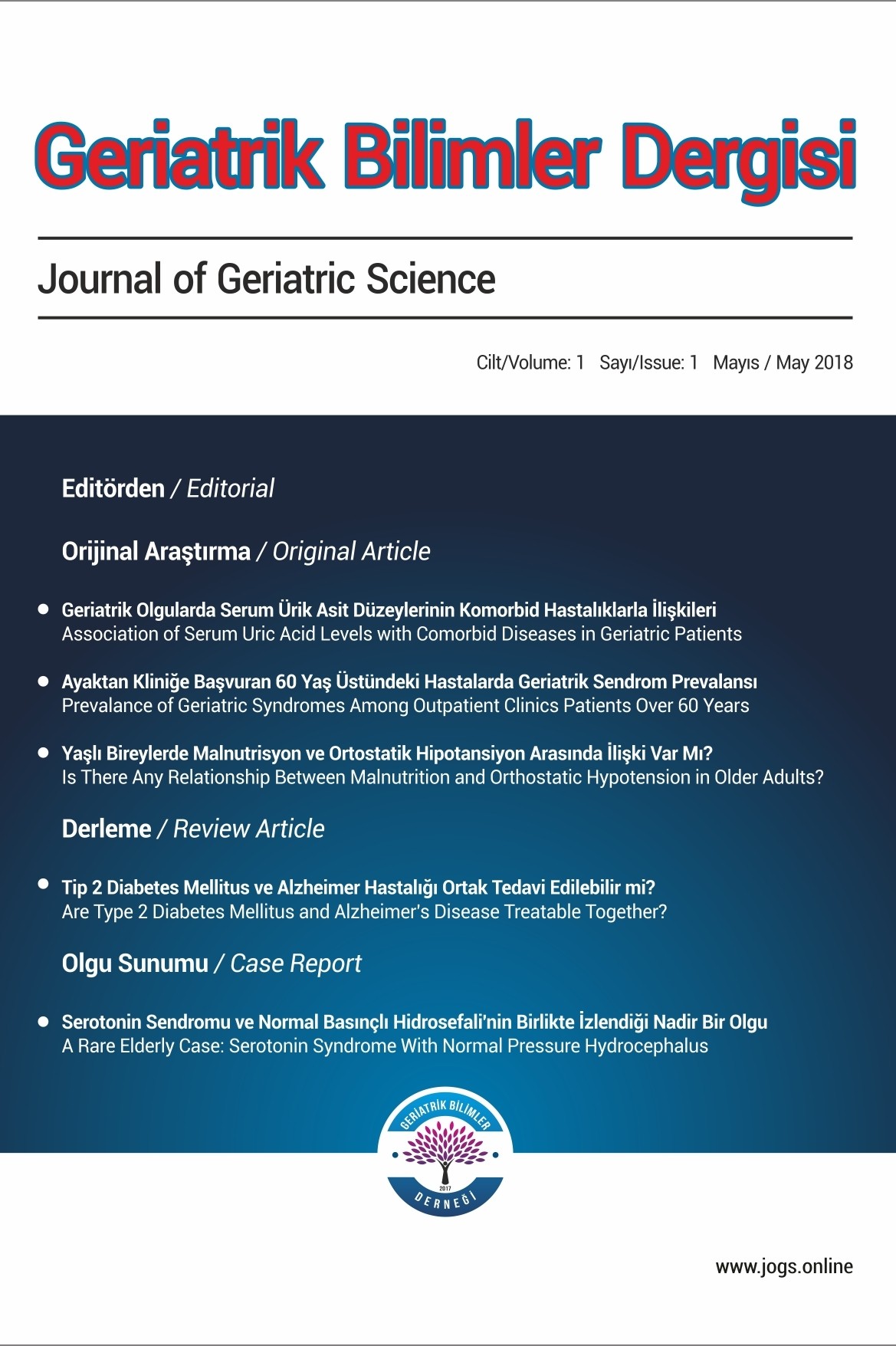Non-Spesifik Bel Ağrılı Yaşlı Bireylerde Yürüme Parametreleri ve Ağrı Şiddeti
non-spesifik bel ağrısı, yaşlı, yürüme parametreleri, ağrı
Gait Parameters and Pain Severity in Elderly with Non-Specific Low Back Pain
non-specific low back pain, elderly, gait parameters, pain,
___
- Referans 1. Kanasi E, Ayilavarapu S, Jones J. The aging population: demographics and the biology of aging. Periodontology 2000. 2016;72(1):13-8.Referans 2. Beard JR, Officer A, de Carvalho IA, Sadana R, Pot AM, Michel JP, et al. The World report on ageing and health: a policy framework for healthy ageing. Lancet (London, England). 2016;387(10033):2145-54.Referans 3. Roberts S, Colombier P, Sowman A, Mennan C, Rolfing JH, Guicheux J, et al. Ageing in the musculoskeletal system. Acta orthopaedica. 2016;87(sup363):15-25.Referans 4. Beyera GK, O'Brien J, Campbell S. Health-care utilisation for low back pain: a systematic review and meta-analysis of population-based observational studies. Rheumatology international. 2019;39(10):1663-79.Referans 5. Maher C, Underwood M, Buchbinder R. Non-specific low back pain. Lancet (London, England). 2017;389(10070):736-47.Referans 6. Chenot JF, Greitemann B, Kladny B, Petzke F, Pfingsten M, Schorr SG. Non-Specific Low Back Pain. Deutsches Arzteblatt international. 2017;114(51-52):883-90.Referans 7. Driscoll T, Jacklyn G, Orchard J, Passmore E, Vos T, Freedman G, et al. The global burden of occupationally related low back pain: estimates from the Global Burden of Disease 2010 study. Annals of the rheumatic diseases. 2014;73(6):975-81.Referans 8. Nascimento P, Costa LOP, Araujo AC, Poitras S, Bilodeau M. Effectiveness of interventions for non-specific low back pain in older adults. A systematic review and meta-analysis. Physiotherapy. 2019;105(2):147-62.Referans 9. Koch C, Hansel F. Chronic Non-specific Low Back Pain and Motor Control During Gait. Frontiers in psychology. 2018;9:2236.Referans 10. Ghamkhar L, Kahlaee AH. Trunk muscles activation pattern during walking in subjects with and without chronic low back pain: a systematic review. PM & R : the journal of injury, function, and rehabilitation. 2015;7(5):519-26.Referans 11. Laird RA, Gilbert J, Kent P, Keating JL. Comparing lumbo-pelvic kinematics in people with and without back pain: a systematic review and meta-analysis. BMC musculoskeletal disorders. 2014;15:229.Referans 12. Radebold A, Cholewicki J, Polzhofer GK, Greene HS. Impaired postural control of the lumbar spine is associated with delayed muscle response times in patients with chronic idiopathic low back pain. Spine. 2001;26(7):724-30.Referans 13. Hodges PW, Tucker K. Moving differently in pain: a new theory to explain the adaptation to pain. Pain. 2011;152(3 Suppl):S90-8.Referans 14. Folstein MF, Folstein SE, McHugh PR. "Mini-mental state". A practical method for grading the cognitive state of patients for the clinician. Journal of psychiatric research. 1975;12(3):189-98.Referans 15. Gungen C, Ertan T, Eker E, Yasar R, Engin F. [Reliability and validity of the standardized Mini Mental State Examination in the diagnosis of mild dementia in Turkish population]. Turk psikiyatri dergisi = Turkish journal of psychiatry. 2002;13(4):273-81.Referans 16. Reed MD, Van Nostran W. Assessing pain intensity with the visual analog scale: a plea for uniformity. Journal of clinical pharmacology. 2014;54(3):241-4.Referans 17. Newell D, Shead V, Sloane L. Changes in gait and balance parameters in elderly subjects attending an 8-week supervised Pilates programme. Journal of bodywork and movement therapies. 2012;16(4):549-54.Referans 18. Gatton ML, Pearcy MJ, Pettet GJ, Evans JH. A three-dimensional mathematical model of the thoracolumbar fascia and an estimate of its biomechanical effect. Journal of biomechanics. 2010;43(14):2792-7.Referans 19. Myers TW. Anatomy Trains E-Book: Myofascial Meridians for Manual and Movement Therapists: Elsevier Health Sciences; 2013.Referans 20. Barker PJ, Briggs CA. Attachments of the posterior layer of lumbar fascia. Spine. 1999;24(17):1757-64.Referans 21. Wilke J, Macchi V, De Caro R, Stecco C. Fascia thickness, aging and flexibility: is there an association? Journal of anatomy. 2019;234(1):43-9.Referans 22. Hides JA, Belavy DL, Cassar L, Williams M, Wilson SJ, Richardson CA. Altered response of the anterolateral abdominal muscles to simulated weight-bearing in subjects with low back pain. European spine journal : official publication of the European Spine Society, the European Spinal Deformity Society, and the European Section of the Cervical Spine Research Society. 2009;18(3):410-8.Referans 23. Hodges PW, Richardson CA. Inefficient muscular stabilization of the lumbar spine associated with low back pain. A motor control evaluation of transversus abdominis. Spine. 1996;21(22):2640-50.Referans 24. Russo M, Deckers K, Eldabe S, Kiesel K, Gilligan C, Vieceli J, et al. Muscle Control and Non-specific Chronic Low Back Pain. Neuromodulation : journal of the International Neuromodulation Society. 2018;21(1):1-9.
- Yayın Aralığı: Yılda 3 Sayı
- Başlangıç: 2018
- Yayıncı: Geriatrik Bilimler Derneği
Yaşlılarda Düşük Yürüme Hızının Mini Nutrisyonel Değerlendirme ile İlişkisi
Neziha ULUSOYLAR ERKEN, Fatma Sena DOST GÜNAY
Yaşlılarda Hiponatremiyle İlişkili Faktörler
Suleyman Emre KOCYIGIT, Ali Ekrem AYDIN
Bezmialem Vakıf Üniversitesi Dragos Hastanesi Palyatif Bakım Ünitesi Verileri
Non-Spesifik Bel Ağrılı Yaşlı Bireylerde Yürüme Parametreleri ve Ağrı Şiddeti
Gülşah ÖZSOY, Nursen İLÇİN, İsmail ÖZSOY, Barış GÜRPINAR, Öznur BÜYÜKTURAN, Buket BÜYÜKTURAN, Caner KARARTI, Senem ŞAŞ
Zehra Margot CELİK, İzel Aycan BASOGLU, Asli YİGİT, Fatma Esra GUNES
